This article was published in Scientific American’s former blog network and reflects the views of the author, not necessarily those of Scientific American
Those of you following me on social media and at patreon will know that I’m currently working my way through the turtle fossil record for the purposes of The Big Book. And, boy, are there a lot of fossil turtles. So it was that I found myself reminiscing of my time during the early 2000s when I shared an office with Sarah Fielding, at the time doing her PhD on fossil turtles. Because I like to be distracted from stuff I’m supposed to be working on, I paid attention and often got inspired by whatever Sarah was looking at. We had live turtles in the office, a preserved turtle on the shelf, and a bunch of fossil turtles from here and there. And among these was the Brazilian specimen that I’m going to tell you about today.
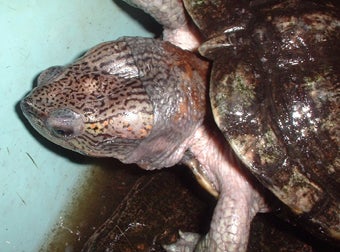
This article isn’t about Cuthbert - one of the turtles who shared our office at the time the research discussed here was conducted - but here he is anyway. Cuthbert, the stuff of legend. Whole articles have been written about him. Credit: Darren Naish
The specimen concerned was a partial, articulated shell (about 18 cm long as preserved) with just one of the hindlimbs, obtained by our then supervisor Dave Martill during his forays in the Nova Olinda region of Ceará, Brazil. We published on the specimen in 2005 (Fielding et al. 2005); I also later discussed it in a review article on Brazilian fossil turtles (Naish 2007). Whatever our interpretation of the turtle, it was significant in being from a geological unit (the ‘mid’ Cretaceous Nova Olinda Member of the Crato Formation) that hadn’t yielded much in the way of turtle material before. I will add that, these days, I wouldn’t publish a paper on a Brazilian fossil without the direct involvement of Brazilians…
On supporting science journalism
If you're enjoying this article, consider supporting our award-winning journalism by subscribing. By purchasing a subscription you are helping to ensure the future of impactful stories about the discoveries and ideas shaping our world today.
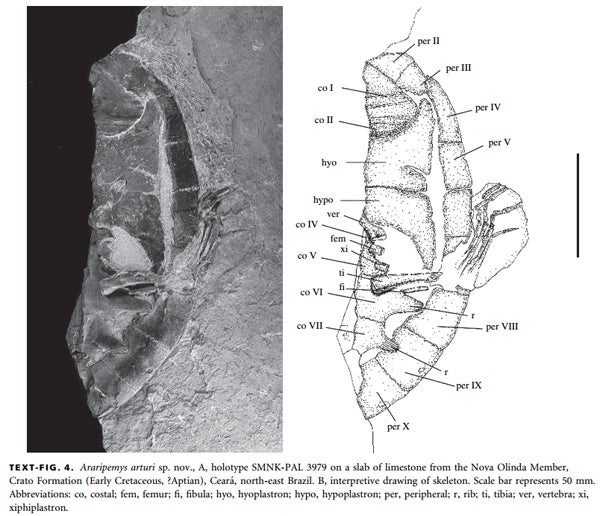
J.Lo - I mean, SMNK-PAL 3979 - the araripemydid as depicted in Fielding et al. (2005). Credit: Fielding et al. 2005
Anyway, the distinctive sculpture on the bones of the plastron and specific configuration and proportions of the shell bones showed to start with that we were dealing with Araripemys, a long-necked, broad-shelled Cretaceous turtle named in 1973. As a Crato Formation fossil, our specimen was somewhat older than other Araripemys fossils: they come from the overlying Santana Formation, a unit suggested by some to be as much as 10 million years younger than the Crato.
What is Araripemys? It’s a pleurodire: a member of the great group of turtles famed for withdrawing their necks laterally rather than vertically and, for this reason, popularly termed side-necked turtles. Pleurodires today are turtles of the southern continents but fossils reveal a former presence in the north as well. More specifically, Araripemys belongs to Pelomedusoides, a clade that includes the modern African side-necked turtles (or pelomedusids), the obscure and extinct euraxemydids and the also extinct but highly diverse, speciose bothremydids (Gaffney et al. 2006). Araripemys has usually been considered distinct enough for its own family (Araripemydidae). It’s typically considered the sole member of this family (this rendering the group redundant as goes phylogenetic nomenclature) but the suggestion has been made that a few other pleurodires might be regarded as araripemydids too.
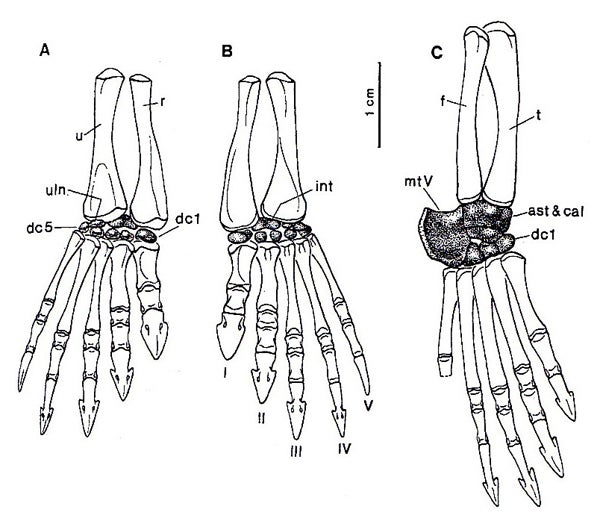
Right manus (hand) of Araripemys barretoi, as depicted by Meylan (1996), in (A) dorsal and (B) ventral views, and (C) right pes (foot). Note the really interesting arrow-shaped unguals. Credit: Meylan 1996
A peculiarity of Araripemys is that its unguals (the bones that form the tips of the digits and typically form the ‘cores’ of the keratinous claws) are shaped like arrowheads (Meylan 1996). Our specimen seemed to lack that, its unguals instead appearing straight and simple. Furthermore, the proportions of its peripherals – the bones that form the outer margins of the carapace – looked different from those of A. barretoi (the type species of Araripemys). Our specimen also seemed to have a rounder posterior margin to the carapace than A. barretoi. In an interview with a journalist, Sarah said in passing how that rounded posterior carapace gave the animal “a bit of a J.Lo”, and so it was that the specimen was duly christened with an honorific that would last for all eternity. Anyway, we deemed these differences significant enough to warrant the naming of a second species of Araripemys: A. arturi, the species name honouring Artur Andrade of the Departamento Nacional de Produção Mineral in Brazil (Fielding et al. 2005).
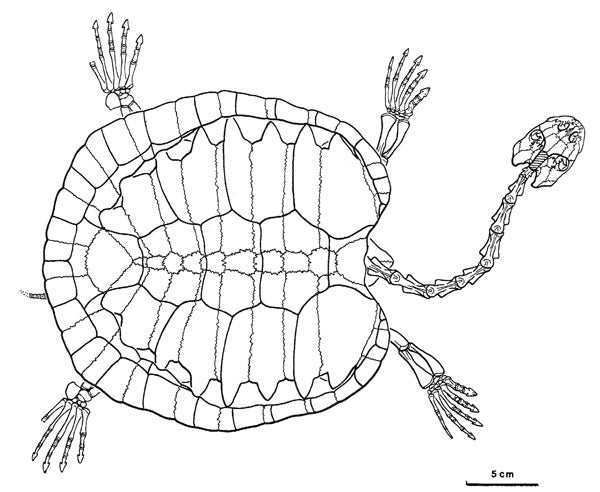
Araripemys barretoi, as reconstructed by Meylan (1996). This is a mid-sized, long-necked pleurodire with a relatively broad shell and obvious nuchal emargination. As is typical for fossil turtles, the slightly feinter lines shown on the shell correspond to the junctions between the bones and the bolder lines correspond to the sulci that mark the positions of the scutes. Credit: Meylan 1996
Perhaps of more significance is that J.Lo preserves the soft tissue outline of its left foot as an external mould. Extensive webbing is clearly present, the skin margins extend well beyond the toe bones, and the result is a rounded paddle where the individual digits were completely encased (bar the claws) in webbing. Tiny ripples and creases correspond to the original skin texture (Fielding et al. 2005). This paddle-like foot is interesting for several reasons, not least because (if correctly interpreted) it suggests strong adaptation to aquatic habits. We likened the appearance and extent of the paddle to that of Carettochelys, the aquatic pig-nosed turtle of New Guinea and northern Australia*. There are several artistic reconstructions of Araripemys out there (beside the one you see here), and it’s notable that this particular foot anatomy has consistently been missed.
* Incidentally, the sole survivor of a group that also previously had a far greater distribution. More on that another time.
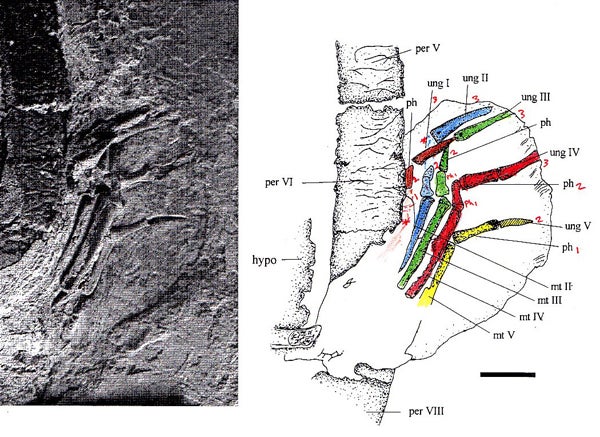
The left hindlimb of our J.Lo Araripemys specimen, showing the mould of a soft tissue paddle (hopefully just about visible in the photo at left). At right, a (previously unpublished) colourised interpretation of the bones (showing some of Sarah's annotations). Arrow-shaped unguals are not obvious, but this could be due to damage or poor preservation. Credit: Darren Naish, Fielding et al. 2005
Prior to our paper there had already been suggestions – based on the form of the limb bones and shoulder girdle – that Araripemys might have been highly aquatic (Kischlat & Campos 1990) and its occurrence within saline lagoons, and its association with fishes and other turtles thought to be marine, had also led some authors to imagine it as a marine turtle of coastal environments (Kellner & Campos 1999). We agreed: our conclusion was that Araripemys was more aquatic, and more marine, than living pleurodires (Fielding et al. 2005). This fits into the broader picture on fossil pleurodires established in papers by Gaffney, Tong, Lapparent de Broin and their colleagues in which it’s established that the pleurodires of the Cretaceous and Paleogene were substantially more diverse than living ones in ecology and habitat choice. Some modern pleurodires occur in brackish waters and will even frequent lagoons, estuaries and make short sea crossings, but they’re predominantly freshwater turtles.
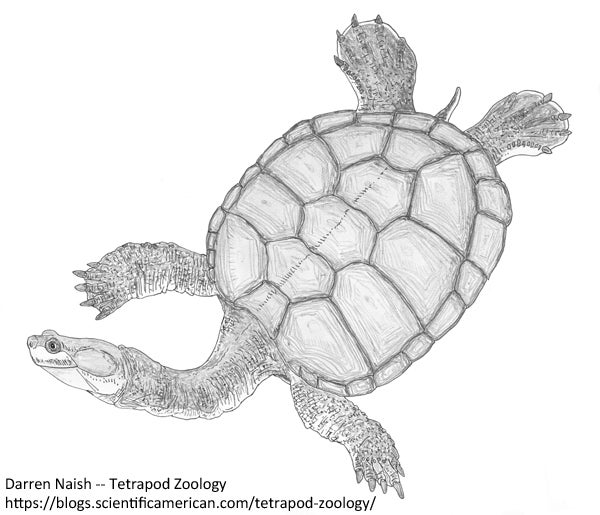
Araripemys in swimming, or playful, pose; a reconstruction. Not meant to be in zero gravity. Credit: Darren Naish
What about the naming of J.Lo as a new species: how has this stood the test of time? It’s said that many claims, proposals and arguments made in the technical literature are never followed up with critique of any sort, leaving their proposers wondering whether they’ve sunk without trace or given the warm embrace of tacit acceptance.
On this occasion, I guess people really, really care about the naming of new species of Brazilian Cretaceous pleurodires. Within a year of our paper’s publication, Gaffney et al. (2006) published their monstrous, long-awaited, 698 page analysis of extinct pelomedusoids. They argued therein that A. arturi looked simply to be a small or young specimen of A. barretoi, the key characters of that taxon being difficult to see or removed due to the way the J.Lo slab had been split. A year later, both Oliveira & Kellner (2007) and Oliveira & Romano (2007) evaluated A. arturi, their conclusions being that the diagnostic characters were not convincing and that the specimen should, again, be considered synonymous with A. barretoi. Ok, I think we get the message. Either way, the significance of J.Lo is that it demonstrates the presence of Araripemys (ostensibly A. barretoi) in the Crato, in sediments somewhat older than those that yielded Araripemys in the first place.
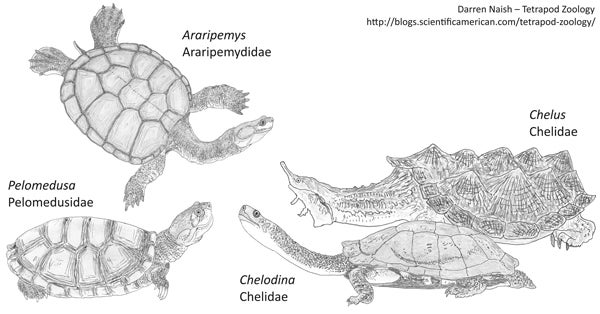
Some pleurodires, extinct but mostly extant. More are coming.... Credit: Darren Naish
Today, J.Lo resides in the collections of the Staatliches Museum für Naturkunde in Karlsruhe, Germany alongside a great many other Brazilian fossils from the Crato and Santana formations. When thinking of Cretaceous animal faunas, we tend to imagine the dinosaurs, pterosaurs, plesiosaurs and other big beasts. But the turtles were always there, doing turtley things…. a great many of them. We will revisit the turtles soon, oh yes.
Reminder: some content here debuted at the Tet Zoo patreon, where you can see progress on The Big Book. Support me for as little as $1 a month and see things coming together.
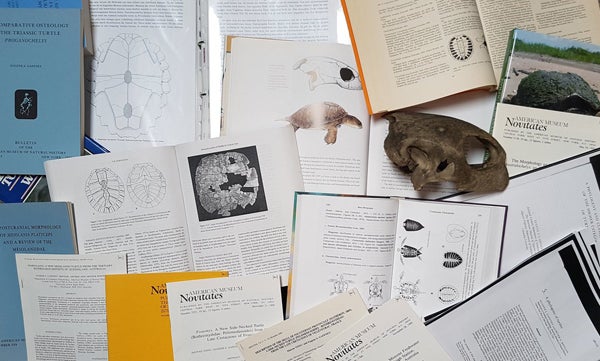
Turtles all the way down. Credit: Darren Naish
For previous Tet Zoo articles on turtles, see…
Gilbert White's pet tortoise, and what is 'grey literature' anyway?
The familiar Matamata, known to us all since the 1700s, and its long, fat neck (matamatas part II)
"Adaptation perfected" (possibly) in a turtle's head (matamatas part III)
Necks for sex? No thank you, we're sauropod dinosaurs (includes brief discussion of Galapagos tortoises)
Turtles that eat bone, rocks and soil, and turtles that mine
Refs - -
Gaffney, E. S., Tong, H. & Meylan, P. A. 2006. Evolution of the side-necked turtles: the families Bothremydidae, Euraxemydidae, and Araripemydidae. Bulletin of the American Museum of Natural History 300, 1-698.
Kellner, A. W. A. & Campos, D. de A. 1999. Vertebrate paleontology in Brazil – a review. Episodes 22, 238-251.
Kischlat, E.-E & Campos, D. de 1990. Some osteological aspects of Araripemys barretoi Price, 1973 (Chelonii, Pleurodira, Araripemydidae). In Atas do I Simpósio sobre a Bacia do Araripe e Bacias Interiores do Nordeste Crato, 14 a 16 de junho de 1990, pp. 387-395.
Meylan, P. A. Skeletal morphology and relationships of the Early Cretaceous side-necked turtle, Araripemys barretoi (Testudines: Pelomedusoides: Araripemydidae), from the Santana Formation of Brazil. Journal of Vertebrate Paleontology 16, 20-33.
Naish, D. 2007. Turtles of the Crato Formation. In Martill, D. M., Bechly, G. & Loveridge, R. F. (eds) The Crato Fossil Beds of Brazil: Window into an Ancient World. Cambridge University Press (Cambridge), pp. 452-457.
Oliveira, G. R. & Kellner, A. W. A. 2007. Taxonomic status of Araripemys “arturi” Fielding, Martill & Naish, 2005 (Testudines, Pleurodira, Araripemydidae). Paleontologia: Cenários de Vida, pp. 385-391.
Oliveira, G. R. & Romano, P. S. R. 2007. Histórico dos achados de tartarugas fósseis do Brasil. Arquivos do Museu Nacional, Rio de Janeiro 65, 113-133.